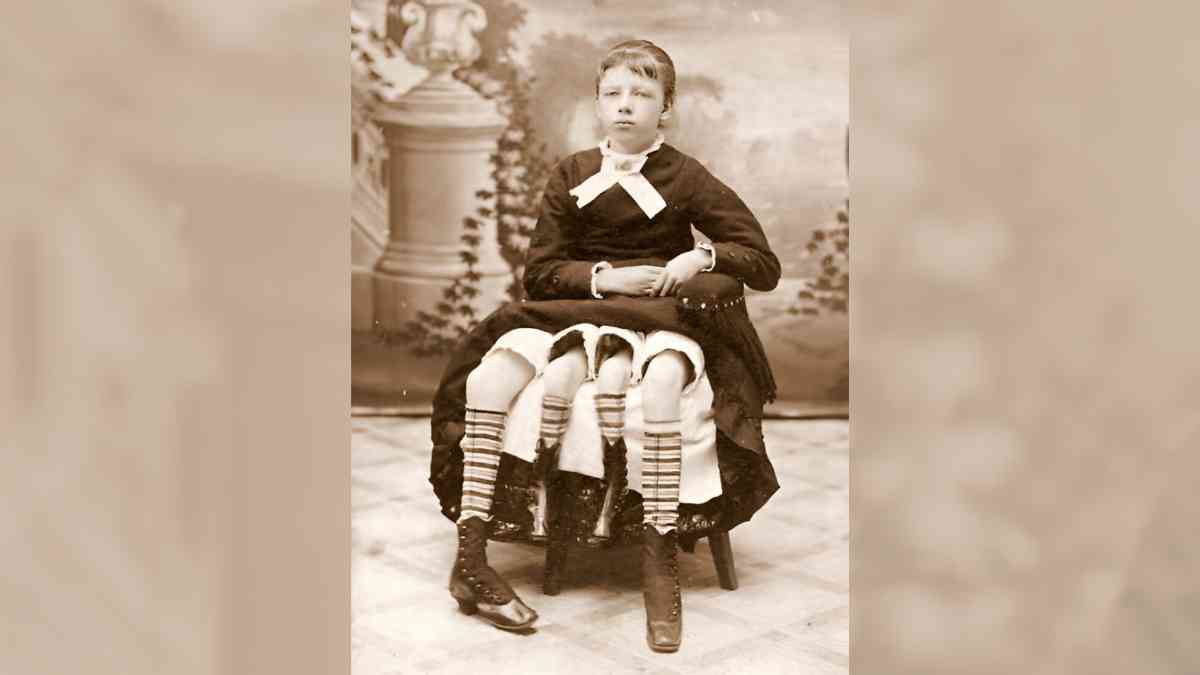Josephine Myrtle Corbin: The Unstoppable Life of the Four-Legged Woman Who Redefined Possibility

Few nineteenth-century stories are as riveting—or as misunderstood—as that of Josephine Myrtle Corbin, the celebrated “Four-Legged Woman.” Born in rural Tennessee with the congenital condition dipygus, she entered a world that often equated physical difference with limitation. Yet Myrtle defied that narrative at every turn, transforming a rare anatomical anomaly into a platform for financial independence, medical discovery, and personal fulfilment. Her journey illuminates the intersection of science, entertainment, and social prejudice—and reminds us that resilience can rewrite any script.
Early Life and Family Background
Josephine Myrtle Corbin was born on May 12, 1868 in Lincoln County, Tennessee, to William H. Corbin and Nancy Sullins Corbin, modest farmers of Scots-Irish descent. Contrary to later press embellishments, her mother’s pregnancy and labour were “typical” until delivery revealed not two infant legs but four—a shock that turned an ordinary birth into medical history. Myrtle weighed roughly ten pounds at three weeks and, aside from her duplicated lower anatomy, appeared vibrant and healthy.
Her parents chose her middle name, “Myrtle,” to evoke the evergreen plant, symbolising endurance. That symbolism proved prophetic: family anecdotes describe her toddling around the homestead, the stronger outer legs bearing her weight while the smaller inner pair dangled or twitched, animated yet too weak to support walking.
Understanding Dipygus: A Nineteenth-Century Medical Marvel
Dipygus, sometimes called posterior dichotomy, results from an incomplete fission of the embryonic axis. The outcome in Myrtle’s case was two separate pelvises aligned side by side, four legs, duplicated reproductive organs, and dual lower digestive tracts. Physicians later catalogued her as dipygus dibrachius tetrapus: one head, two arms, four legs. Contemporary teratologists debated causal theories—maternal trauma, hereditary taint, or conjoined parasitic twinning—yet all agreed her vitality undermined any assumption that severe malformation guaranteed frailty.
Victorian-era journals rendered diagrams of her pelvises and referenced her case in discussions of obstetrics, urology, and orthopaedics. Myrtle would become one of the best-documented bodily anomalies of her century, each article reframing her not as a curiosity alone but as living evidence that reproductive and digestive duplication could remain functional.
Stepping Into the Sideshow Spotlight
By age thirteen, Myrtle’s family, facing mounting farm debts, accepted an offer from travelling showmen. Billed as “The Four-Legged Girl from Texas,” she debuted under a canvas tent with a printed pamphlet praising her as “gentle as summer sunshine and as happy as the day is long.” Audiences flocked to witness her seated in a velvet chair, dainty boots laced over all four feet. Unlike some exhibitions that exploited performers, Myrtle negotiated a lucrative salary—reports cite up to $450 per week, equal to well over $12,000 today—allowing her to send home funds that paid off mortgages and purchased acreage.
Her professional success triggered a wave of imitators—gaffs who strapped puppet limbs to corsets—prompting trade papers to warn patrons to verify the “genuine four-legged girl.” Despite fierce competition, Myrtle’s polite demeanour and authenticity kept her marquees lit across the American South and Midwest.
Public Perception: From Freak Show to Folk Icon
Nineteenth-century America alternated between moral outrage at “freak shows” and fascination with the extraordinary. Myrtle inadvertently bridged that divide. Religious critics criticised the commodification of her body, yet women’s magazines marvelled at her fashionable gowns and refined manners, casting her as proof that physical difference need not preclude femininity or decorum. Testimonials described her taking tea with society ladies after matinees.
Importantly, Myrtle herself controlled her narrative more than many contemporaries. She is quoted instructing photographers to frame her respectfully and refusing any routine that required revealing her torso. In doing so, she asserted bodily autonomy decades before disability-rights language existed.
Love, Marriage, and Double Motherhood
At eighteen, Myrtle astonished tabloids again—this time by marrying Dr. James Clinton Bicknell, a young Maryland-trained doctor she met during a Tennessee engagement. Their union confounded skeptics who believed intimacy impossible. One year later, when she fell ill with fever and abdominal pain, physician Dr. Lewis Whaley discovered that Myrtle’s duplication extended internally: two functioning wombs. The left uterus carried a three-month pregnancy that threatened her life; Whaley reluctantly performed an abortion, documenting the case in the Atlanta Medical and Surgical Journal.
Far from ending her hopes of motherhood, the procedure paved the way for resilience. Between 1889 and 1897, Myrtle delivered five healthy children—three from one uterus, two from the other—each birth recorded with astonishment in obstetric annals. Midwives noted that labour proceeded “as in average cases,” save for careful monitoring to identify which cervix dilated first. Family letters reveal she managed childcare while still accepting occasional performance engagements to fund her children’s schooling.
Physicians, Papers, and the Ethics of Inquiry
Medical fascination shadowed Myrtle for decades. Articles in The British Medical Journal (1888) and the American Journal of Obstetrics (1888) used her pseudonym “Mrs. B.” to explore everything from uterine anatomy to sexual preference—Whaley famously inferred that she “favoured intercourse on the right side.” Such intimate speculation reveals both the era’s scientific curiosity and its insensitivity to patient privacy.
Nonetheless, Myrtle consented to many examinations, recognising that controlled disclosure could correct rumours and contribute to knowledge. Her cooperation aided later surgeons in distinguishing dipygus from parapagus conjoined twins, influencing paediatric interventions still cited today.
Life Beyond the Spotlight
By the early 1900s, with her children approaching adolescence, Myrtle semi-retired to a comfortable home in Cleburne, Texas. Census records list her occupation as “None”—a striking note for someone who once headlined posters nationwide. Yet local newspapers occasionally advertised “one-night-only” returns when bills loomed for college tuition. Even then, she performed in climate-controlled theatres rather than drafty tents, a concession to age and arthritis in her inner knees.
Neighbours recalled a soft-spoken woman who played piano and hosted Sunday dinners. She sewed dresses for her daughters, adjusting patterns so skirts draped neatly over all four legs. Garden paths around her house were extra wide, not to accommodate disability but to prevent the hems of those gowns from dragging in Texas dust.
Death and Unusual Burial
Josephine Myrtle Corbin died of a streptococcal skin infection on May 6, 1928, six days before her sixtieth birthday. Fearing medical trophy hunters—offers had once reached $5,000 for her corpse—her family encased the coffin in concrete and erected a sturdy steel cage (a mortsafe) before backfilling the grave. This grim measure ensured the woman who had navigated sensationalism in life could finally rest undisturbed.
Legacy: What Myrtle Teaches the Twenty-First Century
Redefining “Normal.” Myrtle’s ability to marry, bear children, and manage a household shattered assumptions that anatomical variance equates to incapacity.
Agency in Representation. By negotiating wages and controlling publicity images, she pre-figured modern conversations about self-image and disability rights.
Scientific Progress via Collaboration. Medical insights gleaned with her consent advanced embryology and obstetrics, illustrating ethical partnerships between patient and physician.
Conclusion
Josephine Myrtle Corbin lived at the collision point of curiosity, commerce, and compassion. Her four legs drew crowds, but her determination earned respect; her anatomy confounded doctors, yet her cooperation enlightened them. Long before hashtags and advocacy groups, she championed a belief that dignity is self-defined, not society-assigned. Nearly a century after her passing, her story continues to inspire biomedical research, disability-positive narratives, and anyone who has ever been told they “can’t.”



